#Kobanê Day
Explore tagged Tumblr posts
Text

📢 November 1st is Kobanê Day: Call for Action!
We call on all democratic forces to bring the memory of the great resistance of Kobanê in our solidarity actions in these days. Be creative in your actions, take a black cloth and burn it as the women burned their oppression in Kobanê, you can also make a banner with the slogan “End NATO genocide in the Middle East”, take a video of these actions and send it to us. We will make a video in order to spread the spirit of the internationalist struggle all over the world.
➡️ Full Call: https://internationalistcommune.com/kobane-day-10-years-of-kobane-resistance/
#november 1st#november#november 2024#2024#Kobanê Day#Kobanê#Call for Action#class war#ausgov#politas#australia#international#signal boost#signal b00st#signal boooooost#fuck nato#antinato#nato expansion#nato allies#nato#auspol#tasgov#taspol#fuck neoliberals#neoliberal capitalism#anthony albanese#albanese government#eat the rich#eat the fucking rich#antinazi
2 notes
·
View notes
Text
The October 1st highlighted as "World Kobani Day" we bow down to all freedom fighters who dedicated their lives to liberate Kobanê in Rojava. I especially remind and celebrate the life of the Kurdish singer, teacher and resistance-fighter Viyan Peyman with my piece "Viyan". Peyman lost her life in Kobani in 2015.
Di Roja Cîhanî ya Kobanê de, ji bo bîranîna şervana Kurd Vîyan Peyman ku canê xwe a li Kobanê
feda kir, berhema VÎYAN pêşkêşî we dikim. Bijî berxwedana Kobanê✌🏾🔥
لە رۆژی جیھانی کۆبانێ، بۆ ڕێزلێنان و یاد و بیرەوەری شەرڤانی کورد «ڤیان پەیمان» کە گیانی خۆی لە کۆبانێ بەخت کرد بەرهەمی «ڤیان» پێشکەش دەکەم.✌🏾
👉 Video: Zanyar Omrani
👉 Artwork: Zehra Dogan
👉 watch the full video
youtube
0 notes
Text

Project2025 #TechBros #CorpMedia #Oligarchs #MegaBanks vs #Union #Occupy #NoDAPL #BLM #SDF #DACA #MeToo #Humanity #FeelTheBern
JinJiyanAzadi #BijiRojava International Women’s Day and a Feminist Foreign Policy [UPDATES]
As women continue to be hit by job loss, increased home responsibilities, family caretaking, unaccounted for invisible labor, homelessness and domestic violence, it’s clear the COVID-19 pandemic has revealed underlying institutional and infrastructural inequalities in our society…

RELATED UPDATE: Canada’s inaction in Gaza marks a failure of its feminist foreign policy

RELATED UPDATE: In the shadow of revolution and humanitarian response: understanding aspirations and wellbeing in Northeast Syria

RELATED UPDATE: Where next for feminist foreign policy on funding feminist movements?

RELATED UPDATE: Elûş: AP0 started a social change with his arrival in Kobanê

RELATED UPDATE: Syrian Pro-Opposition Media Outlets: Iranian Islamic Revolutionary Guard Corps (IRGC) Recruiting Minors In Northeast Syria To Fight Syrian Democratic Forces (SDF)

RELATED UPDATE: Diyarbakır Governorate bans the slogan ‘Jin, Jiyan, Azadî’

RELATED UPDATE: End repression of Kurdish women: Thousands march across Europe
https://medyanews.net/end-repression-of-kurdish-women-thousands-march-across-europe/

RELATED UPDATE: Kurdish women characterized with courage, valor
FURTHER READING:
#Project2025#TechBros#CorpMedia#Oligarchs#MegaBanks vs#Union#Occupy#NoDAPL#BLM#SDF#DACA#MeToo#Humanity#FeelTheBern#JinJiyanAzadi#BijiRojava
11 notes
·
View notes
Link
From the protest camp at the Tishrin Dam in Rojava, North-East Syria we call on all the youth organizations, socialists, antifascists, ecologist, women’s movements and everyone that stands against war…
0 notes
Text
Kobane is under attack: Take action and defend the Women's Revolution
from International_Rev/10163 on 12th Dec 2024 via thefreeonline at https://wp.me/pIJl9-Fbd Telegram t.me/thefreeonline/1572 In the last days the fascist Turkish state is intensifiying it’s attacks on Rojava and especially on Kobanê. Erdogans goal is not just to gain territory, but to destroy our visions of socializm, women’s liberation and the unity of the people. This is why Kobane is a…

View On WordPress
0 notes
Text
1ê Mijidarê Roja Kobanê Ya Cîhanê Pîroz Be!
1 Kasım Dünya Kobanê Günü kutlu olsun!
Congratulations to 1 November World Kobanê Day!
今日11月1日は世界コバネーの日‼︎

#kurds#kurdish#kurdistan#syrian kurds#sdf#kurdish ypg#ypj#rojava#jin jiyan azadi#human rights#woman life freedom#syria
9 notes
·
View notes
Text
One Year Since the Turkish Invasion of Rojava: An Interview with Tekoşîna Anarşîst
https://cwc.im/TAinterview
One year ago, Turkish forces invaded Rojava with the blessing of Donald Trump, displacing hundreds of thousands of people, committing summary executions, and seeking to perpetrate ethnic cleansing in order to forcibly resettle the area. Since 2012, the autonomous region of Rojava had hosted a multi-ethnic experiment in self-determination and women’s autonomy while fighting the Islamic State (ISIS). Anarchists participated in resisting the Turkish invasion, some as combat medics on the ground in Syria and others as part of an international solidarity campaign. To this day, Turkish forces continue to occupy a swath of territory in Syria, but they were blocked from conquering the entire region.
Anarchists from around the world have been involved in the experiment in Rojava for many years, joining the YPJ and YPG (“People’s Protection Units”) at the time of the defense of Kobanê against the Islamic State and later forming their own organizations, including the International Revolutionary People’s Guerrilla Forces (IRPGF) and most recently, Tekoşîna Anarşîst (“Anarchist Struggle,” or TA), founded in autumn 2017. In the following extensive interview, several participants in TA compare their experiences fighting the Islamic State and fighting Turkey, explore what has occurred in Syria since the invasion, evaluate the effectiveness of anarchist interventions in Rojava, and discuss what others around the world can learn from struggles in the region.
This is an important historical document drawing on several years of experience and reflection. For anarchists who oppose all forms of hierarchy and centralized coercive force, the establishment of armed self-defense organizations poses many thorny questions. While the following interview does not conclusively answer them, it will inform any discussion of these issues.
88 notes
·
View notes
Photo

Bijî Rizgarîya Kobanê! Berxwedan Jiyane🤍🕊 Her Bijî Kurdistan ✨ “On this day in 2015, the Kurdish city of Kobanê was liberated from the reign of Daesh(Islamic State) by the hands of our resistance fighters and allies. We remember today as a day of courage and celebrate today as a day of hope.” Beautiful art to honor and remember by @elif___kucuk 🧿 https://www.instagram.com/p/CKhK7hKlPBP/?igshid=1msrr87zvmroc
1 note
·
View note
Text

#kobanê#rojava#ypj#ypg#october 31#2024#october 2024#october#signal boost#signal b00st#signal boooooost#class war#world kobane day#kobane#ausgov#politas#auspol#tasgov#taspol#australia#fuck neoliberals#neoliberal capitalism#anthony albanese#albanese government#antinazi#antifaschistische aktion#antifa#anti capitalism#antifascist#antiauthoritarian
0 notes
Photo



Si chiamava Aziza Jalal ed era giovanissima la curda uccisa e mutilata dai filo-turchi Le notizie sono poche: le autorità curde e il comando Ypg ha reso noto il nome della combattente mostrata uccisa in un video messo in rete giorni fa dei jihadisti al soldo di Erdogan. Il nome di battaglia era Amara Renas mentre il nome reale era Aziza Jalal. I tagliagola l'hanno uccisa lo scorso 21 ottobre nel villaggio di Jalabiyya non lontano da Kobanê. globalist
18 notes
·
View notes
Text


Project2025 #TechBros #CorpMedia #Oligarchs #MegaBanks vs #Union #Occupy #NoDAPL #BLM #SDF #DACA #MeToo #Humanity #FeelTheBern
JinJiyanAzadi #BijiRojava Rojda Felat: The feminist taking on Isis [UPDATES]
'We are not weak any more. Women are playing a vital role in leading and managing the society'…
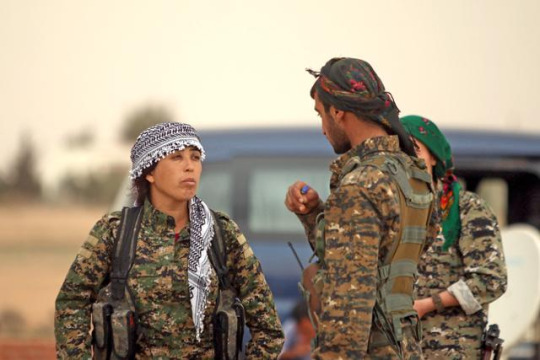
RELATED UPDATE: US-backed assault on Raqqa to last months, commander says

RELATED UPDATE: Raqqa largely liberated, Rojava revolution holds commune elections

RELATED UPDATE: Second military regiment formed in Tabqa

RELATED UPDATE: Rojda Felat: by women's leadership, historic victory achieved in al-Raqqa

RELATED UPDATE: WATCH YPJ Commander killed in Turkish attack in Qamishlo laid to rest in Kobanê
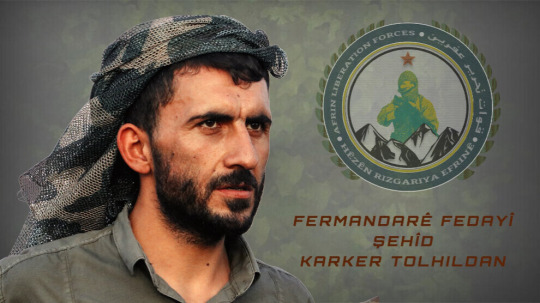
RELATED UPDATE: Afrin Liberation Forces pay tribute to their co-founder Karker Tolhildan

RELATED UPDATE: YPJ announces the death of commander Jinda Cudi in Turkish drone attack

RELATED UPDATE: TJK-E: Let's fill the streets with the slogan 'Jin Jiyan Azadi'
FURTHER READING:
7 notes
·
View notes
Link
2 notes
·
View notes
Link
Campaign to save the civilian population
Moslem said the fight has reached a new level: "Today, a step was taken in Afrin to defend the civilian population. The fight in Afrin and the war are not over. On the contrary, it goes on. The very nature of the war has changed."
"Fighters of YPG and YPJ continue their struggle in Afrin"
"As long as the population was in the city, the conditions for a fight, a war were not present. The Turkish state attacks the civilian population and carries out massacres. The propaganda of the enemy that no one is in Afrin is a lie. Nobody should pay attention to it. Both in the center and surrounding of Afrin there are YPG/YPJ fighters and they fight. A promise has been made to the people and this promise will be kept. Afrin will never be abandoned.”
"The Turkish state aims at the annihilation of the Kurds"
Moslem pointed to the war in the Middle East and said: "With this war, a decision was made to annihilate the Kurds. They want to take Afrin and then attack the Kurds in Kobanê, Qamishlo, Kirkuk and Shengal. First, this was intended to be done via groups such as IS and al-Nusra. Since this was not successful, they do it themselves now. People in all four parts of Kurdistan should be vigilant and see the plans. Our liberation depends on unity. If we do not create unity, do not realize national unity, we will face similar attacks throughout Kurdistan. Therefore, we must not waste any time, Kurdish organizations must come together and fight with a national attitude against these attacks."
Saleh Moslem also pointed to the role of the international powers in the attacks on Afrin: "The international forces, the states of the world, have left us alone. This silence provided a basis for and supported the attacks of Turkey."
"YPG/YPJ will lead a guerilla war in Afrin"
Commenting on the resistance of Afrin, the Kurdish politician said: "For 58 days our people resisted with great self-sacrifice against soldiers of a NATO army and militias. These forces have carried out their attacks with excessive force, air strikes and massive use of technology. The resistance on the other hand is great and holy, everyone should know that.
The resistance has developed with great determination and it continues today. In Afrin, the YPG and the YPJ will continue their resistance in various ways. From now on, they will put the focus of their struggle on the guerrilla warfare. Hit-and-run methods will bring the resistance to the highest level. For a front war we have neither the technical possibilities nor the armament. We are committed to lead a guerrilla struggle. Our youth, our fighters and our forces are ready for it."
134 notes
·
View notes
Text
[EN/FR] Afrin is not alone ! Afrin n’est pas seule !

The fall of the city of Afrin must not prevent to demonstrate the solidarity, the turkish state doesn’t stop in Afrin but want attack the others parts of Rojava.
La chute de la ville d’Afrin ne doit pas empêcher les manifestations de solidarité, l’Etat turc ne s’arrêtera pas à ce canton et prévoit d’attaquer le reste du Rojava.
http://internationalistcommune.com/worldafrinday/
Afrin is not alone, March 24 #WorldAfrinDay The 20th of January the invasion of the canton of Afrin began. This territory located in the western part of the Democratic Federation of Northern Syria has been bombarded mercilessly by fighter jets, artillery and all kinds of modern weaponry which carry the NATO seal. The Turkish army, so as not to dirty their hands and hide the number of casualties in their ranks, is using jihadist militias to carry out the attack. These militias were first a part of Al-Qaeda, in 2014 reorganized as Daesh and they now go under the banner of the FSA. The brutal images the invaders are posting to their social media, as well as their cries calling to war against the infidels, screaming “Allahu Akbar” at the top of their lungs, remind us that Rojava is still fighting the same enemy it once defeated in Kobane and Raqqa. But this time, the flag they stand behind is that of the second largest army of NATO. In addition, the black Daesh flag has been seen in several pictures with the red Turkish flag. Several of the combatants, killed in battle by the self-defense forces resisting in Afrin, have been positively identified as Daesh commanders.
The fascist and misogynistic dictator of the Turkish state, Recep Tayyip Erdogan, has stated publicly that through this invasion against an autonomous territory inside a sovereign country, it wishes to “return Afrin to its real owners”. But behind this charade, it’s actually carrying out an ethnic cleansing and a genocide against the Kurdish people and other minorities, that have been living in Afrin since time immemorial. Afrin has been one of the few territories that has enjoyed a relative peace in the bloody war of Syria that has been raging for the last 7 years. Many families displaced by war, have sought shelter in this territory. Now Erdogan is trying to take advantage of this instability and the suffering that grips the peoples of Syria so as to legitimize its imperialist power grabs, dreaming of reconquering the territories that were once occupied by the Ottoman Empire.
The international community is turning a blind eye to the repeated calls for help that come out of Afrin. Russia’s withdrawal of troops stationed in Afrin gave the green light to the invasion and signals its complicity with the Turkish state. However, this complicity is no smaller than that of NATO’s member states. These are allowing Turkey to use western weaponry and technology to massacre civilians. The Democratic Federation of Northern Siria has been the main force fighting the Islamist barbarism of Daesh, but this seems to be irrelevant for those governments which, since 2014, have been lamenting every massacre that the Daesh propaganda claimed. On the 24th of February, a resolution was unanimously adopted by the UN Security Council for a cease-fire in all of Siria. This offered a glimmer of hope to prevent more civilian massacres. Nonetheless, the silence that has followed the Turkish intensification of its attacks is undeniable.
For its part, Bashar Al-Assad’s Baathist regime, after declaring that it would never allow the invasion of Syrian soil by Turkey, has proven an incapacity to confront the aggression. Despite having anti-aircraft systems that could stop the Turkish Air Force from striking, the regime demanded Afrin total submission to the Syrian state and to give up its autonomy, which has been attained through the revolutionary process that Rojava has seen in the last years. There is no doubt that this invasion is a result of the Sochi agreements between Assad, Russia, and Turkey. The Syrian Arab Army has chosen to avoid any direct confrontation that might oppose Erdogan’s plans and to abandon the Syrian Democratic Forces. Its dependency towards Russia and its enmity towards the Democratic Federation of Northern Syria is allowing the neo-ottoman jihadist forces to occupy Afrin.
The situation is critical. The forces of occupation are at the city gates. A city which shelters not only its inhabitants but numerous refugees that have fled their villages after the destruction caused by the Turkish bombardments. In addition to the massive shelling, there have been chemical attacks reported against civilians, specifically with chlorine gas. However, this is not the full picture of the mayhem caused, vital infrastructures for the survival of the civilian population have been deliberately attacked. A week ago Turkey cut off water and electricity supply to the city forcing its residents to flee. The siege continues and the population faces an impending massacre. Yesterday it was ISIS in Kobane, today it is the Turkish state in Afrin. And as kobane, Afrin will resist, Afrin will win.
The Internationalist Commune of Rojava, having taken into account all these facts, joins the multiple solidarity initiatives with Afrin. We call on everybody to join a day of action and global solidarity, as the one that took place on 1st November 2014 for Kobane.
#WorldAfrinDay will take place on Saturday 24th of March. Solidarity with Afrin will be heard and felt all around the world to prove that Afrin is not alone and that the democratic and antipatriarchal project that is alive in Afrin will be defended worldwide.
#WorldAfrinDay
Long live international solidarity Biji Berxwedana Afrin Afrin n’est pas seul, 24 mars #WorldAfrinDay (24 mars, la Journée mondiale pour Afrin) Le 20 janvier, l’invasion du canton d’Afrin par l’armée turque a commencé. Ce territoire situé dans la partie occidentale de la Fédération Démocratique de la Syrie du Nord a été bombardé sans merci par des avions de chasse, de l’artillerie et toutes sortes d’armes modernes qui portent le sceau de l’OTAN. L’armée turque, pour ne pas se salir les mains et cacher le nombre de victimes dans ses rangs, utilise des milices djihadistes pour mener l’attaque. Ces milices faisaient d’abord partie d’Al-Qaïda, réorganisées en 2014 sous le nom de Daesh, elles sont maintenant placées sous la bannière de l’Armée Syrienne Libre (FSA). Les images brutales que les envahisseurs publient dans les réseaux sociaux, ainsi que leurs cris appelant à la guerre contre les infidèles, criant “Allahu Akbar” à se déchirer les poumons, nous rappellent que le Rojava lutte toujours contre l’ennemi qu���il a déjà vaincu à Kobanê et Raqqa. Mais cette fois, le drapeau qu’ils attaquent est celui de la deuxième plus grande armée de l’OTAN. En outre, le drapeau noir de Daesh a été vu sur plusieurs photos avec le drapeau rouge turc. Plusieurs des combattants, tués au combat par les forces d’autodéfense résistantes d’Afrin, ont été identifiés comme des commandants de Daesh.
Le dictateur fasciste et misogyne de l’Etat turc, Recep Tayyip Erdogan, a déclaré publiquement qu’à travers cette invasion contre un territoire autonome à l’intérieur d’un pays souverain, il souhaite “rendre Afrin à ses véritables propriétaires”. Mais derrière cette mascarade, il y a en fait un nettoyage ethnique et un génocide contre le peuple kurde et d’autres minorités, qui vivent à Afrin depuis des temps immémoriaux. Afrin a été l’un des rares territoires à jouir d’une paix relative dans la guerre sanglante syrienne qui fait rage depuis 7 ans. De nombreuses familles déplacées par la guerre ont cherché refuge dans ce territoire. Aujourd’hui, Erdogan tente de profiter de cette instabilité et des souffrances qui s’emparent des peuples de Syrie pour légitimer ses prises de pouvoir impérialistes, rêvant de reconquérir les territoires jadis occupés par l’Empire ottoman. La communauté internationale ferme les yeux sur les appels répétés à l’aide lancés par Afrin. Le retrait des troupes russes stationnées à Afrin a donné le feu vert à l’invasion et marque sa complicité avec l’Etat turc. Toutefois, cette complicité n’est pas moindre que celle des États membres de l’OTAN. Celles-ci permettent à la Turquie d’utiliser les armes et la technologie occidentales pour massacrer des civils. La Fédération démocratique de la Syrie du nord a été la principale force de lutte contre la barbarie islamiste de Daesh, mais cela semble sans importance pour les gouvernements qui, depuis 2014, déplorent chaque massacre revendiqué par la propagande de Daesh. Le 24 février, le Conseil de sécurité des Nations unies a adopté à l’unanimité une résolution pour un cessez-le-feu dans l’ensemble de la Syrie. Cela a offert une lueur d’espoir pour empêcher d’autres massacres civils. Néanmoins, le silence qui a suivi l’intensification turque de ses attaques est indéniable.
Pour sa part, le régime baasiste de Bachar Al-Assad, après avoir déclaré qu’il ne permettrait jamais l’invasion du sol syrien par la Turquie, s’est révélé incapable de faire face à l’agression. Bien qu’ayant des systèmes antiaériens qui pourraient empêcher la force aérienne turque de frapper, le régime exigeait une soumission totale d’Afrin à l’État syrien et de renoncer à son autonomie, ce qui a été atteint grâce au processus révolutionnaire que le Rojava a connu ces dernières années. Il ne fait aucun doute que cette invasion est le résultat des accords de Sochi entre Assad, la Russie et la Turquie. L’armée arabe syrienne a choisi d’éviter toute confrontation directe qui pourrait s’opposer aux plans d’Erdogan et d’abandonner les forces démocratiques syriennes. Sa dépendance à l’égard de la Russie et son hostilité à l’égard de la Fédération démocratique de Syrie du Nord permettent aux forces néo-ottomanes djihadistes d’occuper Afrin.
La situation est critique. Les forces d’occupation sont aux portes de la ville. Une ville qui abrite non seulement ses habitants mais aussi de nombreux réfugiés qui ont fui leurs villages après les destructions causées par les bombardements turcs. Outre les bombardements massifs, des attaques chimiques ont été signalées contre des civils, en particulier avec du chlore gazeux. Cependant, ce n’est pas le tableau complet du désordre causé, les infrastructures vitales pour la survie de la population civile ont été délibérément attaquées. Il y a une semaine, la Turquie a coupé l’approvisionnement en eau et en électricité de la ville, forçant ses habitants à fuir. Le siège se poursuit et la population est confrontée à un massacre imminent. Hier c’était Daesh à Kobanê, aujourd’hui c’est l’État turc à Afrin.
La Commune Internationaliste du Rojava, ayant pris en compte tous ces faits, s’associe aux multiples initiatives de solidarité avec Afrin. Nous appelons tout le monde à se joindre à une journée d’action et de solidarité mondiale, comme celle qui a eu lieu le 1er novembre 2014 pour Kobanê. Et comme Kobanê hier, Afrin résistera, Afrin vaincra. Le WorldAfrinDay aura lieu le dimanche 24 mars. La solidarité avec Afrin sera entendue et ressentie partout dans le monde pour prouver qu’Afrin n’est pas seule et que le projet démocratique et anti-patriarcal qui vit à Afrin sera défendu dans le monde entier.
#WorldAfrinDay
Longue vie à la solidarité internationale !
Biji Berxwedana Afrin !
#worldafrinday#afrinoperasyonu#defend afrin#afrin operasyonu#afrin#efrin#international solidarity#Rojava#kurdistan#revolution
31 notes
·
View notes
Text
Film - FEAR US WOMEN | Women Fighting Isis
Her philosophy is partly spelled out on her arm, in a tattoo’ed poem that reads in English and Arabic. “They don’t deserve to live in my world.”

Hanna Bohman left her life in Vancouver, British Columbia in 2014 and joined the Yekîneyên Parastina Gel (YPG) women’s militia of the Kurdish People’s Defense Unit, better known as the YPJ. She has spent the better part of three years on two tours of duty in Syria, as part of a fighting forceaiming to eliminate the scourge of Isis in one small town after another. “People find it weird, I know,” she says. “I wanted to make a difference.”
I had the opportunity to spend part of an afternoon with Bohman recently as she prepared to screen Fear Us Women, a new documentary featuring her story at the Women In Entertainment Conference in Los Angeles. The short documentary is a production of RYOT Films, Academy Award-nominated director David Darg and executive producer Olivia Wilde.
“This is really all about something bigger,” Bohman says. “Right now, there are 10,000 women fighting life-or-death battles. But it’s also about the liberation of women in the Middle East. They’re trying to dismantle a thousand years of patriarchy.”
The film will be available online on November 9th, on Go90.
Only 27 minutes long, it’s a gritty look at the horrors of Isis and the wrenching politics of the region – she’s no fan of Turkey’s President Recep Tayyip Erdoğan, for example. But it excels as a matter-of-fact look at the experiences of the often unlikely soldiers who come together for the cause. “I didn’t know a lot of girls before,” she says in the film, looking askance at some young women who were dancing during some down time in camp. “We eat in the dirt, we sleep in the dirt, we do everything in the dirt,” she says of the grim boredom of guard duty.
After volunteering for the YPJ, Bohman was smuggled over the border into Syria, and thrown into the deep end. She expected a five-day boot camp. “It was about four hours of training,” she says. “Luckily I knew how to shoot a gun.”
A confluence of events led the former part-time model and store clerk to leave her Western life and take up arms against a force she calls the “Satanic State.” One was a near-death experience on her motorcycle. “I was thinking about my life, and giving back,” she said. “We build our lives out of opportunity.” Then, horrified by a video she’d seen about Isis, she became incensed at the inaction of governments. She also wondered why, if people could volunteer to fight with them, why there wasn’t an opportunity to fight against them. “Turns out there was.”
While there is no trailer for the film online, I would point you to Bohman’s video diaries, which make up a good portion of the documentary.
In this clip, we find Bohman explaining with an almost unsettling good humor one of the most important battles in her military career. It was the retaking of a big town near the Turkish border called Til Abyad, that had been held by Daesh for nearly a year. “Isis has a huge flag there,” she says to her camera, then laughs. “And we’re attacking them with six of us.”
This attack came after the brutal siege on nearby Kobanê, which while successful, killed 741 of her YPJ sisters. (She explores the wreckage of Kobane here.) At Til Abyad, she’s the only woman available to fight.
In this subsequent video, she explains that the group of six soldiers had grown to a band of twenty, who had been joined by some members of the Free Syrian Army. They were awaiting for airstrikes to finish the job. “We’re going to spend the night here on the dirt on the hill,” she says with soldiers from Croatia and Kurdistan.
It’s a big cognitive and physical leap from Vancouver to Syria. But Bohman tells me, “I’m just wired to fight, I guess.” She talks about the things she’s seen – the aftermath of torture and rape, the decimation of people and cultures that Isis has caused, the many combatants she’s dispatched without a second thought. “Isis believes that if they’re killed by women, they go to hell,” says the trained sniper who is happy to send them there. “I don’t see them as human anymore.”
But the YPJ doesn’t stop their work when Isis retreats, and this is what matters now, she says. The women soldiers have earned the respect of the grateful communities they liberate. “They’re setting up councils and democratic forms of local government,” where women have a seat at the table. From what she’s seeing, the changes seem to be taking. “And that’s a revolution,” says Bohman. “That’s the story.”
#fear us women#film#women#womens rights#human rights#isis#terrrorism#women fighters#women's liberation#middle east#vancouver#syria#Hanna Bohman#yekîneyên parastina gel#kurdish#documentary#documentary film
1 note
·
View note
Text
What Is Burning the Amazon? A Plea from Brazilian Anarchists
As the fires in the Amazon rainforest continue to burn, our comrades in Brazil have sent us this analysis of the causes of the catastrophe and how it should inform our vision of the future.
“I worry about whether the whites will resist. We have been resisting for 500 years.”
—Ailton Krenak
Living Dystopia
The scene is gloomy. On August 19, 2019, smoke covers cities across the state of São Paulo, turning day into night at 3 pm. The previous day, in Iceland, people organized the first funeral, complete with a gravestone and a minute of silence, for a glacier declared dead. The smoke that engulfed São Paulo is caused by forest fires in the Amazon Forest far away in the North of Brazil; the glacier has disappeared due to rising temperatures related to the carbon dioxide accumulating in the atmosphere.
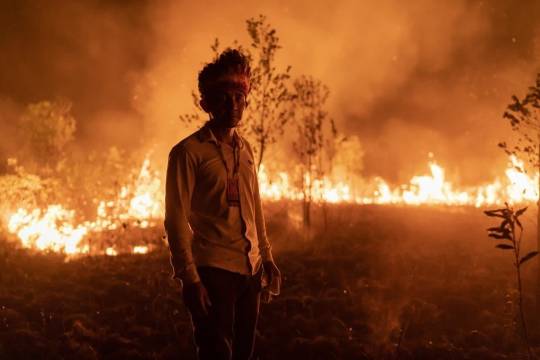
Chief of the Tenharim people of southern Amazonas fighting wildfire.
These tragic scenes—almost picturesque, almost absurd—could sound comical if they weren’t real. They are so extreme that they remind us of fictional scenarios such as those described in the novel And Still the Earth, a Brazilian environmental dystopia by Ignácio de Loyloa Brandão. Written in the 1970s during the military dictatorship in Brazil, the book describes a fictitious dictatorial regime known as “Civiltar,” which celebrates cutting down the last tree in the Amazon with a jingoistic declaration that it has created “a desert greater than that of the Sahara.” In this story, all the Brazilian rivers are dead; jugs of water from each of the extinct rivers are displayed in a hydrographic museum. Aluminum can dunes and highways permanently blocked by the shells of abandoned cars are the backdrop of São Paulo. The city itself suffers from sudden heat pockets capable of killing any unsuspecting person; mysterious diseases consume the citizens, especially the homeless.
The author claims that he was inspired by real events that seemed absurd and unusual at the time. Today, these are becoming ever more ordinary.
News of the increased burning of the Amazon has sent shockwaves around the world. Burns rose 82% in 2019 over the same period last year in Brazil, according to the National Institute for Space Research, and new outbreaks of fire are still being reported as we write. The catastrophic images of destruction have fueled the indignation of people around the world who are concerned about the future of life on earth, seeing how important the Amazon rainforest is for climate regulation and global biodiversity. Images of the fires compelled French President Emmanuel Macron to bring the subject to the G7 summit and to exchange barbs with President Jair Bolsonaro in the media after France offered millions of dollars in funds to fight forest fires.
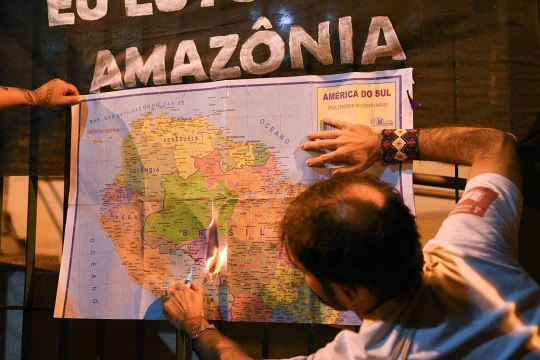
Protest against deforestation in the Amazon, in São Paulo, August 23, 2019.
Since the end of 2018, half a billion bees have been found dead in four Brazilian states. The death of these insects that are essential to fertilizing 75% of the vegetables we eat is linked to the use of pesticides banned in Europe but permitted in Brazil. In August 2019, the court dismissed the charges against a farmer who used pesticides thrown from a plane as a chemical weapon against Guyra Kambi’y indigenous community in Mato Grosso do Sul in 2015. The same month, groups of farmers, “land grabbers” [people who falsify documents in order to obtain ownership of land], union members, and traders used a Whatsapp group to coordinate setting fires in the municipality of Altamira, Pará, the epicenter of fires consuming the Amazon rainforest. As reported in Folha do Progresso, the “day of the fire” was organized by people encouraged by the words of Jair Bolsonaro: “The goal, according to one of the leaders speaking anonymously, is to show the president that they want to work.”
The recent wave of fires linking President Jair Bolsonaro’s policies to attacks against forests, peasant farmers, and indigenous peoples is an intensification of a process as old as the colonization of the Americas. While the Workers’ Party (PT) was still in power, many projects were introduced to expand and accelerate growth, including the construction of the Belo Monte plant, which displaced and impacted indigenous communities and thousands of other people living in the countryside. The approval of the Forest Code in 2012 enabled farmers to advance over indigenous territories and nature reserves with impunity, while suspending the demarcation of new protected lands.
Both left and right governments see nature and human life chiefly as resources with which to produce commodities and profit. The government of Bolsonaro, a declared enemy of the common people, women, and indigenous groups, doesn’t just threaten us with the physical violence of police repression. In declaring that he will no longer recognize any indigenous land, Bolsonaro is intensifying a war on the ecosystems that make human life possible—a war that long precedes him.
A 500-Year-Running Disaster
For centuries, we have struggled to survive the greatest disaster of our time, a disaster that threatens the sustainability of all the biomes and communities on this planet. Its name is capitalism—the cruelest, most inequitable, and destructive economic system in history. This threat is not the result of the inevitable forces of nature. Humans created it and humans can eliminate it.

Anarchists in Sao Paulo on August 23, 2019 protesting against the government and against the deforestation of the Amazon: “Burn fascists, not forests!”
In Brazil, we have witnessed firsthand how this system exploits people, promotes genocide, and degrades and pollutes the earth, water, and air. Even if we ultimately manage to abolish it, we will still have to survive the consequences of letting it go on for so long. The destruction of entire ecosystems, the poisons in rivers and in our own bodies, the species that have gone extinct, the glaciers that have disappeared, the forests that have been cut down and paved over—these consequences will remain for many years to come. In the future, we will have to survive by gathering what we need from the ruins and waste that this system has left in its wake. All the material that has been torn from the ground to be strewn across the earth’s surface and dumped into the seas will not return overnight to the depths it came from.
Recognizing this should inform how we envision our revolutionary prospects. It is foolish to imagine that the abolition of capitalism will expand that the consumer activities that are currently available to the global bourgeoisie to the entire human population; we must stop fantasizing about a regulated post-capitalist world with infinite resources to generate the sort of commodities that capitalist propaganda has led us to desire. Rather, we will have to experiment in ways to share the self-management of our lives amid the recovery of our biomes, our relationships, and our bodies after centuries of aggression and exploitation—organizing life in regions that have become hostile to it.
The ways we organize our resistance today should be informed by the fact that our revolutionary experiments will not be taking place in a world of peace, stability, and balance. We will be struggling to survive in the midst of the consequences of centuries of pollution and environmental degradation. The best-case scenario for the future will look like the situation in Kobanê in 2015: a victorious revolution in a bombed-out city full of mines.
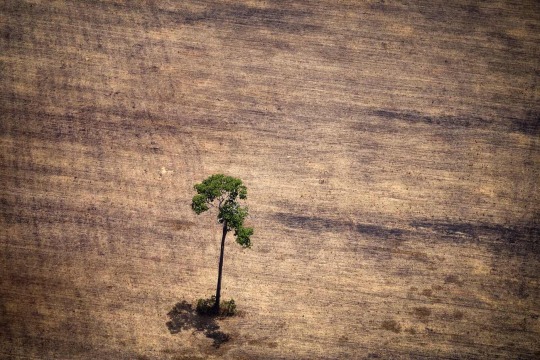
Last stand: neither utopias nor dystopias—revolution!
So What Is Burning the Amazon?
There is a consensus among scientific researchers, government institutions, social movements, and rural and urban peoples regarding the impacts and risks of global warming and increasing industrialization and urbanization. Some of these consequences are about to become irreversible. The deforestation of the Amazon itself may become irreparable if it reaches 40% of its total area.
It has never worked to demand that governments solve these problems for us—and it never will. This is especially foolish when we are talking about the environmental disasters caused by their own policies. Land seizures and the deforestation of the Amazon are inextricably interlinked with the organized criminal enterprises that smuggle and kill in the countryside. Fully 90% of the timber harvested is contraband supported by a vast apparatus of illegal capitalism involving armed militias and the state itself.
Populist leaders like Bolsonaro aim to benefit from the unfolding ecological catastrophe at the same time that they deny it is occurring. On the one hand, they claim that there is no need for action to curb global warming—alongside Trump, Bosonaro was the only other leader who threatened to abandon the Paris Agreement, claiming that global warming is a “fable for environmentalists.” This helps to mobilize the far-right base, which admires and celebrates outright dishonesty as a demonstration of political power. On the other hand, as the consequences of climate chaos and environmental imbalances become obvious undeniable facts, these leaders will opportunistically take advantage of environmental crises, product shortages, refugee migrations, and climate disasters such as hurricanes as pretexts to accelerate the implementation of ever more authoritarian measures in the fields of health, transportation and security. Using authoritarian and militarized means to determine who can have access to the resources they need to survive in a context of widespread scarcity is what many theorists have called ecofascism.
The intervention of foreign states in the Amazon forests according to their own economic interests is simply the continuation of the colonialism that began in 1492. No government will solve the problem of fires and deforestation. At best, they might slow the impact of the exploitation they have always engaged in. Neoliberal capitalism demands endless growth, mandating the transformation of forests and soil into competitive consumer goods on the global market.
So what is burning the Amazon—and the entire planet? The answer is clear: the pursuit of land, profit (legal or not), and private property. None of this will be changed by any elected or imposed government. The only truly environmental perspective is a revolutionary perspective seeking the end of capitalism and the state itself.
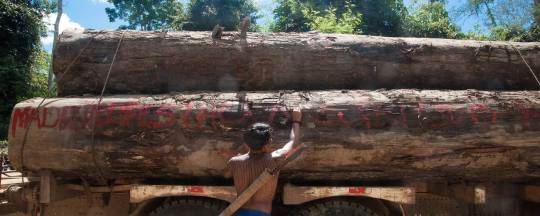
Mundurukus warriors without state support set out for direct action to expel loggers from the Sawré Mybu Indigenous Land in Pará.
Exercising Our Ability to Imagine
The dystopian images of And Still the Earth and George Orwell’s novel 1984 were intended as warnings: exaggerated projections of the worst that can happen if we fail to change the course of history. Today, with cameras around every corner and our own TVs and cell phones carrying out surveillance on us, it is as if these dystopian novels are being used as a handbook for governments and corporations to bring our worst nightmares into reality.
Dystopias are warnings; but utopias, by definition, represent places that do not exist. We need other places, places that are possible. We need to be able to imagine a different world—and to imagine ourselves, our desires, and our relationships being different as well.
We should use the creativity that enables us to picture zombie apocalypses and other literary or cinematic calamities to imagine a reality beyond capitalism right now and begin building it. Today, as reality surpasses fiction, our activities are largely characterized by disbelief and passivity. But you cannot be neutral on a moving train—especially not one that is accelerating on a track into the abyss. Crossing your arms is complicity. Likewise, acting individually is insufficient because it maintains the logic that has brought us here.
We have to rediscover revolutionary reference points for self-organized and egalitarian collective life. We need to share examples of real societies that have resisted the state and capitalism, such as the anarchist experiments during the Russian and Ukrainian Revolutions of 1917 and the Spanish Revolution of 1936. We should remember, also, that all of these were ultimately betrayed and crushed by, or with the connivance of, the Bolshevik Party and the Stalinist dictatorship that followed it, which carried out unprecedented industrialization and the mass displacement of agrarian peoples. This illustrates why it is so important to develop a way of imagining that does not simply replicate the visions of capitalist industrialism.
We can also look to contemporary examples like the Zapatista Uprising in Mexico since 1994 and the ongoing revolution in Rojava in northern Syria. But in addition to the examples offered by anarchists or influenced by anarchist principles, we should learn from the many the indigenous nations around us: Guaranis, Mundurukus, Tapajós, Krenaks, and many others who have ceaselessly resisted European and capitalist colonial expansion for five centuries. They are all living examples from whom anarchists can learn about life, organization, and resistance without and against the state.
If there is any fundamental basis for solidarity in response to the attack on the foundation of all life in the Amazon, it is the potential that we can build connections between the social movements, the poor, and excluded of the world and the indigenous and peasant peoples of all Latin America. To put a halt to the deforestation underway in the Amazon and countless similar forms of destruction that are taking place across the planet, we must nourish grassroots movements that reject the neoliberal resource management of soil, forests, waters, and people.
For a solidarity between all peoples and exploited classes, not between paternalism and the colonialism of governments! The only way to address the environmental crisis and global climate change is to abolish capitalism!
Another end of the world is possible!
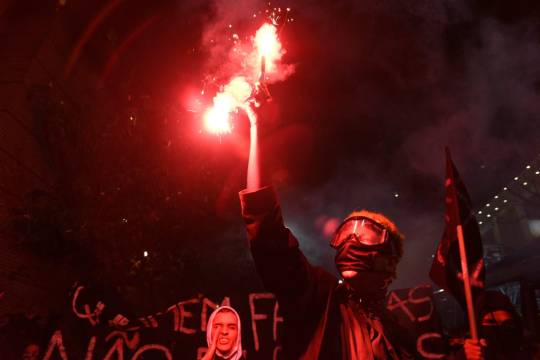
55 notes
·
View notes